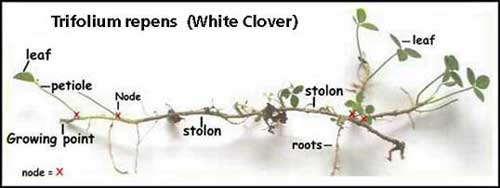How to Grow Clover
How to Grow the White Clover Plant
PLANT HISTORY:
White Clover, trifolium repens L. is considered by many authorities to be the Original Irish Shamrock. When the rare fourth leaf occurs, you have the "Lucky" Four-leaf Clover. The name "Shamrock" is used to describe several different plants. The Columbia Encyclopedia describes the Shamrock as "a plant with leaves composed of three leaflets." The plants sold around St. Patrick's Day are usually a type of Oxalis plant, since true clovers need full sun and do not grow well indoors.
PLANT CHARACTERISTICS:
White Clover, trifolium repens L. is a low growing perennial herb. The plant grows from the tip by sending out "runners" (called Stolens) that take root, and new "runners" are formed from each rooting point.

The seeds are produced in a white fluffy flower head. For White Clover to prosper, the soil should be well drained, kept moist and grown in full to moderate sun. They should be grown in trays or flower boxes that will allow the tips to make contact with the soil to produce the "runners". If grown indoors, they must be in a sunny location or the stems will stretch and the plant will become "leggy" with small leaves.

The seeds are produced in a white fluffy flower head. For White Clover to prosper, the soil should be well drained, kept moist and grown in full to moderate sun. They should be grown in trays or flower boxes that will allow the tips to make contact with the soil to produce the "runners". If grown indoors, they must be in a sunny location or the stems will stretch and the plant will become "leggy" with small leaves.
GROWING FROM SEED:
1. Seeds can be sown in small pots or trays using any moist, well drained soil mix. For best results, we recommend using a packaged seed starting mix.
2. The seeds should be distributed on the moist soil surface and lightly covered with additional soil. Use 1/4 teaspoon of seeds for 1 square foot of area. The pot or tray should be placed in a shaded location until the seeds germinate, which will be in about a week. Keep the soil moist and do not allow soil to dry out. After the seeds germinate and leaves appear move to a SUNNY location.
3. When two or three true clover leaves (3 Leaf) have formed, you can begin fertilizing with an all-purpose fertilizer at the recommended rate for the container. If necessary, thin-out weak plants. Plants should fill out in 8-10 weeks.
4.Transplant when roots appear at the bottom of the pot drainage holes.
2. The seeds should be distributed on the moist soil surface and lightly covered with additional soil. Use 1/4 teaspoon of seeds for 1 square foot of area. The pot or tray should be placed in a shaded location until the seeds germinate, which will be in about a week. Keep the soil moist and do not allow soil to dry out. After the seeds germinate and leaves appear move to a SUNNY location.
3. When two or three true clover leaves (3 Leaf) have formed, you can begin fertilizing with an all-purpose fertilizer at the recommended rate for the container. If necessary, thin-out weak plants. Plants should fill out in 8-10 weeks.
4.Transplant when roots appear at the bottom of the pot drainage holes.
TRANSPLANTING:
Depending on how you started your seeds, you'll want to transplant to a larger container when roots appear out the bottom of the pot or tray. Be careful not to damage the roots when transplanting. Use a well-draining soil mix. After transplanting continue fertilization as before.
INDOOR CARE:
Keep plants watered (make sure container drains well) and keep in a SUNNY location. Continue fertilization as before. Try to keep tips in contact with the soil and remove any damaged leaves. Growing outdoors in full sun is preferred for best growth and flowering.
OUTDOOR CARE:
Outdoor care is the same as indoor care, except increase the fertilization to the recommended outdoor amount for container plants. Clover can also be planted in outdoor beds. Plants will go dormant during winter and re-emerge in the spring.
SEED STORAGE:
If you are storing seed for future planting, seal seed package and store in a cool, dry area. For prolonged storage, you can refrigerate or freeze seeds.
